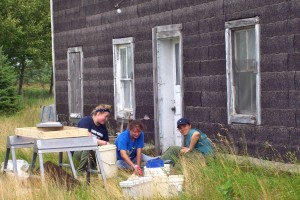Deb Rotman, Ph.D., RPA
Department of Anthropology
University of Notre Dame
drotman@nd.edu
Beaver Island is an incredibly fascinating location for nineteenth-century Irish immigration. We hope to secure grant funding and return to the island SOON!
Project Summary
This archaeological and historical project allows scholars and students to investigate an aspect of the Irish Diaspora that is currently virtually unknown – that is, the lived experiences of Irish immigrants who settled away from the large urban centers on the East Coast. Importantly, however, this project is also an opportunity for students to receive training in archaeological field and laboratory methods  as well as engage in professional development activities through their own research projects. A key element of the project is involving the local community in this public archaeology project by including them in the field excavation, laboratory processing and analyses, scholarly lectures, as contributors of oral histories, and as participants in the Project Archaeology workshop.
as well as engage in professional development activities through their own research projects. A key element of the project is involving the local community in this public archaeology project by including them in the field excavation, laboratory processing and analyses, scholarly lectures, as contributors of oral histories, and as participants in the Project Archaeology workshop.
Millions of Irish people left their homeland in the 18th through the 20th centuries and emigrated to the United States, the United Kingdom, Australia, Argentina, and countless other places around the world. Since 2006, my students and I have been investigating Irish immigrant experiences in South Bend, Indiana, including archaeological excavation in the city as well as archival research and oral history collection in both Ireland and the United States. Beginning in 2010, this project expanded to include Beaver Island, Michigan, which was inhabited in the late nineteenth century by immigrants from Árainn Mhór off the coast of Co. Donegal.
At present, the lives of Irish immigrants to America are understood almost exclusively through investigations of large urban centers like Boston and New York. Smaller communities in the Midwest, such as South Bend (1865-1920) and Beaver Island (1856-1903), however, had economic, social, and political structures that were more fluid than those of the long-established urban enclaves on the East Coast and offered different opportunities to immigrants. Consequently, archaeological and historical investigation of these smaller and more isolated communities will contribute significantly to our understanding of the Irish Diaspora in America by elucidating lived experiences in small towns and rural fishing villages not previously explored.
It is so very interesting to learn more and more about my ancestors (O’Donnells, Sweeny, Gallagher, Boyle) and their travails and trimuphs after being evicted from Arranmore and ending up on Beaver. I look forward to my next visit to Beaver in 2013 (O’Donnell reunion) and to Ireland the year after. Thank you for all the research you’re doing. The history of the man-made famine is important for everyone to understand. The cruelty and injustices fostered upon the Irish is a lesson we can all learn from.
So excited to see this – my family (O’Donnell’s and Malloys) settled in Beaver Island around 1864. I have visited Beaver Island but have yet to get to Árainn Mhór…..it is on the bucket list!
Forgot to say, Annie Proulx (of Brokeback Mountain fame) gave a reading at the West Cork Literary Festival a few years back and while in Bantry was researching the flow of rural migrants from here to the Western US. If I recall correctly, she was exploring the thorny issue of how these European migrants may have contributed to environmental degradation in their new homeland.
Great to see this research being done. Irish people from the remote Sheep’s Head Peninsula of West Cork trod a path to the rural lands of Montana and Wyoming. There was a mining connection from the former copper miners of Allihies on West Cork’s Beara Peninsula to the mines of Butte but the farmland of the Rocky Mountain states called to these farming people too. No coincidence that Idaho has such a reputation for potato growing.
I am always interested in the history of Ireland and her people. My maiden name is Gallagher and although I don’t think I am related to any of the Gallagher’s who resided on Beaver Island – I’m still in love with the stories.
I did visit Beaver Island when I was a young teenager with my family and I cherish the smiles and laughter that made the time so much fun.
My GGrandparents emigrated from Arrain Mhor Island to Beaver Island arriving on the Countess of Arran Mhor on the fourth of July,1866. My GGrandfather, CAPTAIN Owen Gallagher was the Coast Guard captain on the island for 37 years. I have traveled to Arran Mhor island four times and have located cousins whom I am in touch with. The connection is still strong.
This is exciting news. As both a Notre Dame grad and a former resident of Beaver Island, I know how special both places are.